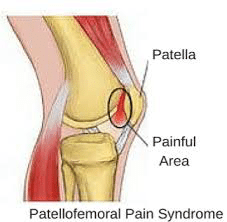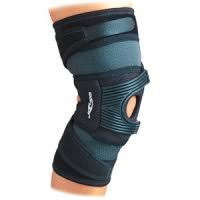Patellofemoral Pain Syndrome
Patellofemoral Pain Syndrome (PFPS) also known as runners knee, chondromalacia patellae, anterior knee pain and patellofemoral joint syndrome is a generic term used to describe patella pain at the front of the knee.
Patellofemoral pain syndrome is one of the most common knee complaints of both the young active sportsperson and the elderly.
Patellofemoral pain syndrome is the medical term for pain felt behind your kneecap, where your patella (kneecap) articulates with your thigh bone (femur). This joint is known as your patellofemoral joint.
Patellofemoral pain syndrome is mainly due to excessive patellofemoral joint pressure from poor kneecap alignment, which in time, affects the joint surface behind the kneecap (retro-patellar joint).
Causes of Patellofemoral Pain Syndrome
Your patella normally glides up and down through the femoral groove. As your knee is bent, pressure between your kneecap and the groove increases.
This retro-patellar pressure is further increased if the patella does not glide normally in the groove, but “mistracks” more to one side, making it rub against the femur.
Repeated trauma causes an increase in retro patellar joint forces, which leads to kneecap pain, joint irritation and eventually degeneration of the patella joint surface.
The most common causes of patellar malalignment is abnormal muscle imbalance and poor biomechanical control.

Poor foot posture (eg flat feet) and weak hip control muscles can both allow your knee to abnormally twist and result in a lateral deviation of your patella.
When poor biomechanics are repeated with each step of your walking or running pattern that poor habit repeatedly traumatises your patellofemoral pain.
Aching kneecaps (patellofemoral pain) affect 25% of the population at some time in their lives but it is more common in athletes. The sports where patellofemoral pain syndrome is typically seen are those when running, jumping and landing or the squatting position is required.
Sports include running, tennis, netball, football, volleyball, basketball, skiing and other jumping sports.
Untreated patellofemoral pain syndrome can also predispose you to patellar tendonitis.
Symptoms
Symptoms include an aching pain in the knee joint, particularly at the front of the knee around and under the patella. There is often tenderness along the inside border of the kneecap and swelling will sometimes occur after exercise. Patellofemoral pain is often worse when walking up and down hills or sitting for long periods of time.
Other signs a sports medical practitioner may pick up include a click or cracking sound when bending the knee, wasting of the quadriceps muscles if the injury is an old one and tight muscles around the knee joint.
Squatting, kneeling, hopping, running or using stairs are commonly painful. As your patellofemoral pain syndrome progresses your knee will become painful while walking and then ultimately even at rest.
Treatment
Patella pain treatment and rehabilitation is based around reducing symptoms, identifying the causes and strengthening or re-training muscles which may have contributed to the injury.
Wearing a patella tracking knee brace or support may help. Certain patella taping techniques are excellent for helping to control the position of the patella and relieve symptoms.


A Podiatrist can confirm the diagnosis and rule out other conditions which may have similar symptoms. Your Podiatrist may prescribe anti-inflammatory medication such as ibuprofen which should not be taken if you have asthma.
Sports massage can help loosen tight structures and muscles which may be contributing. Gait analysis can also be done to determine if the athlete over pronates and orthotic inserts can correct poor foot biomechanics. In chronic cases a Podiatrist may resort to more invasive treatment options such as injection therapy or prolotherapy.
Finally a surgeon may operate to release the tight lateral structures of the knee although there is little evidence as to the success of surgery.
At the Foot and Ankle Clinic our highly qualified team of Podiatrists are all members of the Australian Podiatry Association and offer a combined 50 years’ experience. They are trained to diagnose and effectively treat patellofemoral pain syndrome via a range of proven treatments.
Put your feet in our hands! See us today in Chadstone, East Bentleigh, Moe, Sale, Traralgon, Warragul & Online Store and Retail Enquiries. NO REFERRAL NEEDED!.


